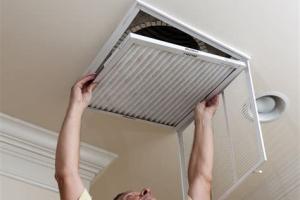Ultimate Guide on How to Change Your Air Filter: Step-by-Step Instructions

-
Quick Links:
- 1. Understanding the Importance of Air Filters
- 2. Types of Air Filters
- 3. When to Change Your Air Filter
- 4. Tools Needed to Change Your Air Filter
- 5. Step-by-Step Guide to Changing Your Air Filter
- 6. Common Mistakes to Avoid
- 7. Expert Tips for Maintaining Air Filters
- 8. FAQs
1. Understanding the Importance of Air Filters
Air filters play a crucial role in maintaining indoor air quality and ensuring the efficient operation of HVAC systems. They trap dust, pollen, pet dander, and other airborne particles, preventing them from circulating in your home. According to the EPA, changing air filters regularly can improve your home’s air quality and boost your HVAC system's efficiency.
2. Types of Air Filters
Air filters come in various types, each designed for specific purposes. Here’s a breakdown of the most common types:
- Fiberglass Filters: Affordable, disposable filters that capture large particles.
- Pleated Filters: These have a larger surface area for trapping particles and are more efficient than fiberglass filters.
- HEPA Filters: High-Efficiency Particulate Air filters are designed to trap 99.97% of particles that are 0.3 microns or larger.
- Electrostatic Filters: These use static electricity to attract and capture particles.
- Carbon Filters: Excellent for eliminating odors, these filters contain activated carbon.
3. When to Change Your Air Filter
Knowing when to change your air filter is vital for maintaining air quality and HVAC efficiency. Here are some guidelines:
- Check monthly during peak usage months.
- Change every 1-3 months for standard filters.
- Consider more frequent changes if you have pets or allergies.
4. Tools Needed to Change Your Air Filter
Changing an air filter is a simple task that requires minimal tools:
- New air filter (ensure it matches your HVAC system specifications)
- Screwdriver (if your filter is secured by screws)
- Step stool or ladder (for high-placed filters)
5. Step-by-Step Guide to Changing Your Air Filter
Step 1: Turn Off the HVAC System
Before you begin, ensure that your HVAC system is turned off. This prevents it from drawing air while you’re changing the filter.
Step 2: Locate the Air Filter
The air filter is typically located in the return air duct or inside the furnace/air handler. Refer to your unit's manual if you're unsure.
Step 3: Remove the Old Filter
Carefully slide the old filter out of its slot. Take note of the filter's orientation (arrows on the filter indicate airflow direction) for proper installation of the new filter.
Step 4: Check for Dust and Debris
Inspect the area for dust and debris. Use a vacuum or a damp cloth to clean the surrounding area.
Step 5: Insert the New Filter
Install the new filter by ensuring it follows the airflow direction indicated by the arrows. Make sure it's snugly fit to prevent air leaks.
Step 6: Turn the HVAC System Back On
Once everything is securely in place, turn your HVAC system back on and check for any unusual sounds or issues.
6. Common Mistakes to Avoid
- Forgetting to turn off the HVAC system before changing the filter.
- Installing the filter backward.
- Using a filter that does not fit properly.
7. Expert Tips for Maintaining Air Filters
To prolong the life of your air filters and maintain optimal air quality, consider the following tips:
- Use high-quality filters that are appropriate for your HVAC system.
- Keep your home clean to reduce dust and allergen accumulation.
- Consider investing in a smart thermostat that reminds you when it’s time to change the filter.
8. FAQs
What happens if I don’t change my air filter?
Not changing your air filter can lead to reduced airflow, decreased energy efficiency, and poor indoor air quality.
How can I tell if my air filter needs changing?
If the filter appears dirty or clogged, it’s time for a change. You can also check the manufacturer's recommendations.
Can I wash and reuse my air filter?
Only specific filters, like electrostatic or HEPA, are washable. Check the manufacturer's guidelines before attempting to clean a filter.
How do I know what size filter to buy?
The size is typically printed on the side of the filter. If not, measure the filter's dimensions before purchasing a new one.
Are higher MERV ratings better?
A higher MERV rating indicates better filtration, but ensure your HVAC system can handle the increased airflow resistance.
Can I change my air filter myself?
Yes, changing an air filter is a simple DIY task that most homeowners can do without professional help.
How often should I check my air filter?
Inspect your air filter monthly, and replace it every 1-3 months, depending on usage and filter type.
What types of air filters are best for allergies?
HEPA filters are highly recommended for allergy sufferers as they capture a large percentage of airborne allergens.
Do air filters affect energy bills?
Yes, a clean air filter can improve HVAC efficiency, potentially lowering your energy bills.
Where can I buy air filters?
Air filters are available at home improvement stores, online retailers, and sometimes directly from HVAC manufacturers.
Random Reads